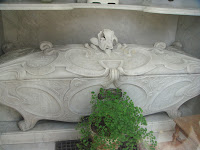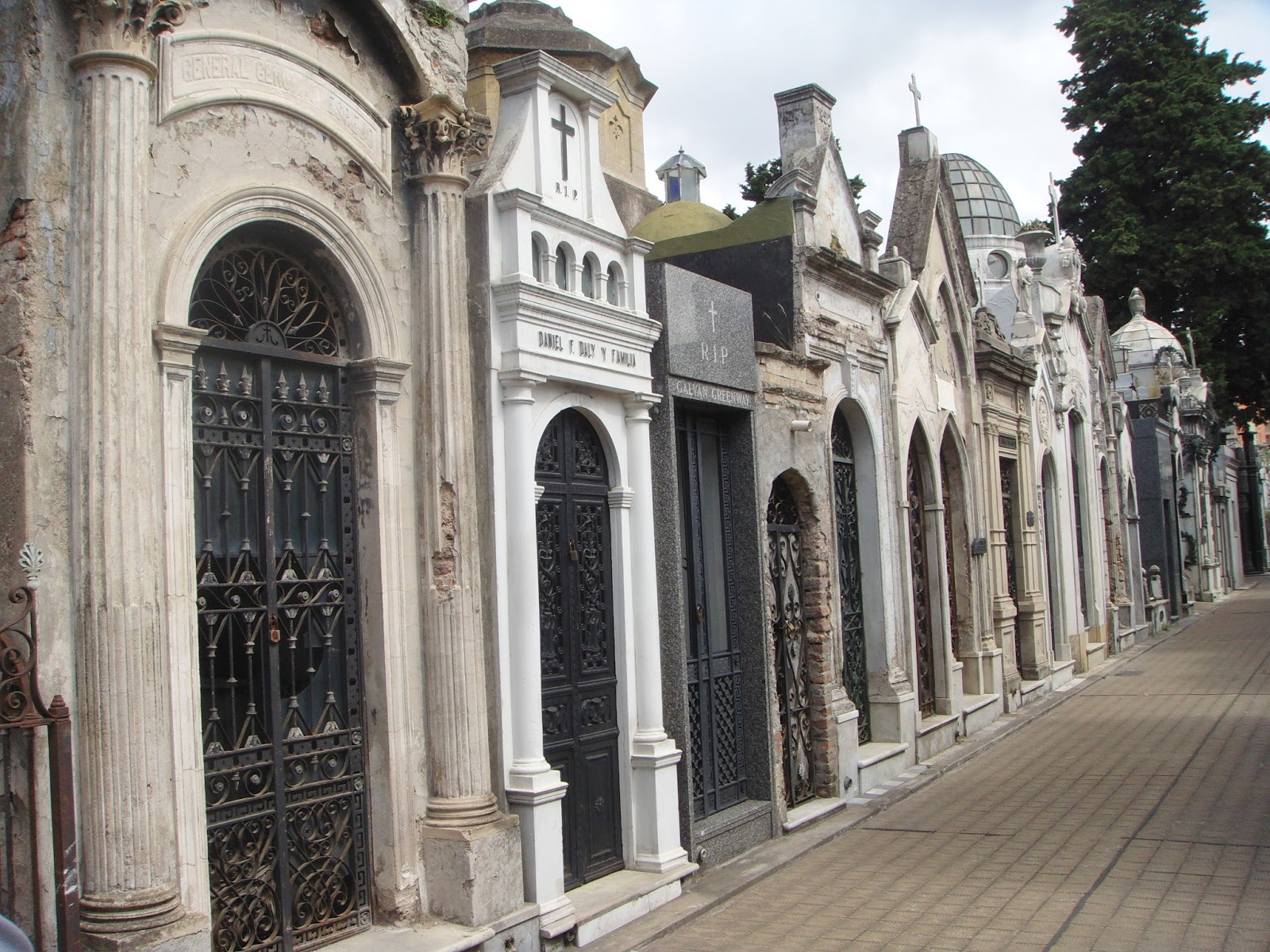[Note: Special thanks to CH for giving me the idea for this blog ]
When my wife and I travel there are three kinds of places we always try to see besides the usual tourist sites: community markets, hardware stores, and cemeteries. You can learn a lot about a culture from these places -- the quality and variety of people's food, the gizmos and gadgets in their homes, their attitudes and beliefs about life and death. And besides being interesting and informative we've found these places are enjoyable because people in them are almost always friendly and welcoming (or at least very quiet).
Cemeteries have always been fascinating to me, even when I was a child. My early interest was no doubt fueled in part by ghost stories and the allure of mysterious and possibly dangerous realms, captured brilliantly by the graveyard in the Disney attraction "Haunted Mansion." As I've gotten older I've come to appreciate that cemeteries are much more than the repositories of dead bodies, however. They are places where history is tangible and personal, cultural values and beliefs are embodied in architectural style, and social structure is clearly and sometimes poignantly discernible in stone. Here are a few of my favorites.
Cemeteries: A Walk Through Both Personal and Monumental History
Death figures prominently in the history of all communities, and cemeteries offer a poignant look at historical events and the role of death in individual families. For example, in many cemeteries we have seen gravestones of several very young children in one family all dying within a short time of each other, probably from some epidemic for which there was no defense at the time. The angst of these families as they revisited the grave site to bury yet another of their children is almost palpable.
One of my favorites in this category is a Louisiana cemetery we came across while driving between New Orleans and Baton Rouge. We saw the expected prevalence of local sons who perished in the Civil War, a vivid reminder of the horrors of that conflict. A history lesson less prominent in the history books was portrayed by one plot where the family patriarch was buried alongside his several wives who successively died during childbirth, a common risk for women in those times. The same cemetery revealed that women often died at a younger age than men but the few who did survive wound up living longer than the oldest men. Evolution in action?
For monumental burial sites there is one that stands out for me, though around the world I have a number of other favorites. By "monumental" I mean containing the remains of many influential and prominent people in western history. Although it is not technically a cemetery, Westminster Abbey in London is the final resting place of an astonishing number of historical figures, marked by gravestones set in the cathedral floor: Isaac Newton, Charles Darwin, Geoffrey Chaucer, Charles Dickens, George Frederic Handel, Henry Irving, David Livingstone, etc., etc. These legendary names seemed almost mythical until I stood on top of the spot where they were buried -- the tangible evidence of their deaths made their lives seem more real for me.
Somber and Vast
Two cemeteries are tied in this category: The American Military Cemetery in Normandy, France and Arlington National Cemetery in Virginia.
The American Cemetery in Normandy contains the remains of more than 9,000 soldiers who died in
 World War II, many during the invasion of France in 1944. The emotional impact of standing in the center of thousands of identical white crosses stretching in perfect alignment as far as you can see is difficult to describe. Arlington National Cemetery in Virginia is also vast and has the added somber quality of covering conflicts dating from the Civil War to the present day. Both of these places are vivid reminders of warfare's deadly effects but Arlington's historical perspective suggests that war is a continuing and perhaps inevitable force in human societies. Wars do not prevent wars.
World War II, many during the invasion of France in 1944. The emotional impact of standing in the center of thousands of identical white crosses stretching in perfect alignment as far as you can see is difficult to describe. Arlington National Cemetery in Virginia is also vast and has the added somber quality of covering conflicts dating from the Civil War to the present day. Both of these places are vivid reminders of warfare's deadly effects but Arlington's historical perspective suggests that war is a continuing and perhaps inevitable force in human societies. Wars do not prevent wars.
Spooky
I have two favorites that stand out in my memory. The first was a small cemetery my wife and I came across while visiting Vermont during the fall. It was set on a hill not far from a small picturesque New England town. Huge old hardwood trees were scattered among the tombstones, many of which were tilting helter-skelter from lack of attention. We visited the cemetery one morning when the fog made the scene gauzy and out of focus. It was eerily quiet, except for the sound of dew dropping from the trees onto the leaves. Like I said, spooky.
Another spooky place is St. Louis No. 1 Cemetery in New Orleans. Established in 1789, this was New Orleans' first cemetery and resembles a small city, with the house-like whitewashed tombs laid out along streets. Many of the crypts mimic the French urban architecture style in vogue at the time, adding to the city-of-the-dead visual effect. Among the residents here is the famous Voodoo priestess Marie Laveau, whose tomb always has a strange assortment of offerings outside, and has many "X's" marked on it by devotees who use this to ask Marie to grant them a wish. There are other Voodoo practitioners buried in the cemetery as well, and if you wander around in here long enough you're guaranteed to get goose-bumps.
Architectural Delights
My hands-down favorite in this category is La Recoleta Cemetery in Buenos Aires, Argentina. It was founded in 1822 on the grounds of a former monastery and was Buenos Aires' first public cemetery. Some of the buildings of the old religious order are still there, notably the beautiful little church built in 1732. Buenos Aires was a very prosperous and sophisticated place during the 1800's and early 1900's, and the wealth of many of its citizens shows in the magnificence of their tombs. Many of them were built in the Neo-Gothic style of the 19th century using marble and granite imported from France and Italy, and look like small European cathedrals.
But the real stars for me are the tombs in the Art Nouveau and Art Deco styles, and I think La Recoleta must have one of the highest concentrations of them in the world. Art Nouveau was popular around the turn of the 19th century, 1890-1910 and was characterized by soft, organic lines and flowery designs. An absolute gem of this style is the tomb of a young woman named Rufina Cambaceres who died in 1902, and even includes an Art Nouveau casket. Rufina was 19 years old when she died and there are some who believe she may have been accidentally buried alive after having a seizure, awoke in her coffin and then died of exhaustion trying to escape. Regardless, the tomb is a masterpiece of Art Nouveau, one of several in the cemetery.

Art Deco flourished in the late 20's and 30's. It is characterized by bold, blocky lines and simple yet powerful designs. Recoleta tombs in this style are more prevalent than those in Art Nouveau which I think reflects the growth in the numbers of wealthy Argentinians. In fact, several of the tombs even look a bit like banks, including that of Eva Peron, one of its most famous residents. Hers pales in comparison though to many, many others.
Closing the Lid

There are quite a few more cemeteries I could mention in other categories, like "Humorous Headstones" (Valparaiso, Chile) and "Culturally Distinctive" (Cairo, Egypt), but I'll stop here. Please feel free to share your own favorites.
One final observation is that cemeteries are the ultimate equalizers. The
most elaborate and grand tombs and headstones, meant to convey status, social superiority, and religious piety crumble and decay the same as the most humble monuments -- it may take more time but eventually entropy will win. And though people fervently believe otherwise, this is equally true for all religions and creeds, including non-believers. Maybe that's the ultimate lesson that cemeteries can teach us.
When my wife and I travel there are three kinds of places we always try to see besides the usual tourist sites: community markets, hardware stores, and cemeteries. You can learn a lot about a culture from these places -- the quality and variety of people's food, the gizmos and gadgets in their homes, their attitudes and beliefs about life and death. And besides being interesting and informative we've found these places are enjoyable because people in them are almost always friendly and welcoming (or at least very quiet).
Cemeteries have always been fascinating to me, even when I was a child. My early interest was no doubt fueled in part by ghost stories and the allure of mysterious and possibly dangerous realms, captured brilliantly by the graveyard in the Disney attraction "Haunted Mansion." As I've gotten older I've come to appreciate that cemeteries are much more than the repositories of dead bodies, however. They are places where history is tangible and personal, cultural values and beliefs are embodied in architectural style, and social structure is clearly and sometimes poignantly discernible in stone. Here are a few of my favorites.
Cemeteries: A Walk Through Both Personal and Monumental History
Death figures prominently in the history of all communities, and cemeteries offer a poignant look at historical events and the role of death in individual families. For example, in many cemeteries we have seen gravestones of several very young children in one family all dying within a short time of each other, probably from some epidemic for which there was no defense at the time. The angst of these families as they revisited the grave site to bury yet another of their children is almost palpable.
One of my favorites in this category is a Louisiana cemetery we came across while driving between New Orleans and Baton Rouge. We saw the expected prevalence of local sons who perished in the Civil War, a vivid reminder of the horrors of that conflict. A history lesson less prominent in the history books was portrayed by one plot where the family patriarch was buried alongside his several wives who successively died during childbirth, a common risk for women in those times. The same cemetery revealed that women often died at a younger age than men but the few who did survive wound up living longer than the oldest men. Evolution in action?
For monumental burial sites there is one that stands out for me, though around the world I have a number of other favorites. By "monumental" I mean containing the remains of many influential and prominent people in western history. Although it is not technically a cemetery, Westminster Abbey in London is the final resting place of an astonishing number of historical figures, marked by gravestones set in the cathedral floor: Isaac Newton, Charles Darwin, Geoffrey Chaucer, Charles Dickens, George Frederic Handel, Henry Irving, David Livingstone, etc., etc. These legendary names seemed almost mythical until I stood on top of the spot where they were buried -- the tangible evidence of their deaths made their lives seem more real for me.
Somber and Vast
Two cemeteries are tied in this category: The American Military Cemetery in Normandy, France and Arlington National Cemetery in Virginia.
The American Cemetery in Normandy contains the remains of more than 9,000 soldiers who died in
Spooky
I have two favorites that stand out in my memory. The first was a small cemetery my wife and I came across while visiting Vermont during the fall. It was set on a hill not far from a small picturesque New England town. Huge old hardwood trees were scattered among the tombstones, many of which were tilting helter-skelter from lack of attention. We visited the cemetery one morning when the fog made the scene gauzy and out of focus. It was eerily quiet, except for the sound of dew dropping from the trees onto the leaves. Like I said, spooky.
Another spooky place is St. Louis No. 1 Cemetery in New Orleans. Established in 1789, this was New Orleans' first cemetery and resembles a small city, with the house-like whitewashed tombs laid out along streets. Many of the crypts mimic the French urban architecture style in vogue at the time, adding to the city-of-the-dead visual effect. Among the residents here is the famous Voodoo priestess Marie Laveau, whose tomb always has a strange assortment of offerings outside, and has many "X's" marked on it by devotees who use this to ask Marie to grant them a wish. There are other Voodoo practitioners buried in the cemetery as well, and if you wander around in here long enough you're guaranteed to get goose-bumps.
Architectural Delights
My hands-down favorite in this category is La Recoleta Cemetery in Buenos Aires, Argentina. It was founded in 1822 on the grounds of a former monastery and was Buenos Aires' first public cemetery. Some of the buildings of the old religious order are still there, notably the beautiful little church built in 1732. Buenos Aires was a very prosperous and sophisticated place during the 1800's and early 1900's, and the wealth of many of its citizens shows in the magnificence of their tombs. Many of them were built in the Neo-Gothic style of the 19th century using marble and granite imported from France and Italy, and look like small European cathedrals.
But the real stars for me are the tombs in the Art Nouveau and Art Deco styles, and I think La Recoleta must have one of the highest concentrations of them in the world. Art Nouveau was popular around the turn of the 19th century, 1890-1910 and was characterized by soft, organic lines and flowery designs. An absolute gem of this style is the tomb of a young woman named Rufina Cambaceres who died in 1902, and even includes an Art Nouveau casket. Rufina was 19 years old when she died and there are some who believe she may have been accidentally buried alive after having a seizure, awoke in her coffin and then died of exhaustion trying to escape. Regardless, the tomb is a masterpiece of Art Nouveau, one of several in the cemetery.
Art Deco flourished in the late 20's and 30's. It is characterized by bold, blocky lines and simple yet powerful designs. Recoleta tombs in this style are more prevalent than those in Art Nouveau which I think reflects the growth in the numbers of wealthy Argentinians. In fact, several of the tombs even look a bit like banks, including that of Eva Peron, one of its most famous residents. Hers pales in comparison though to many, many others.
Closing the Lid
There are quite a few more cemeteries I could mention in other categories, like "Humorous Headstones" (Valparaiso, Chile) and "Culturally Distinctive" (Cairo, Egypt), but I'll stop here. Please feel free to share your own favorites.
One final observation is that cemeteries are the ultimate equalizers. The
most elaborate and grand tombs and headstones, meant to convey status, social superiority, and religious piety crumble and decay the same as the most humble monuments -- it may take more time but eventually entropy will win. And though people fervently believe otherwise, this is equally true for all religions and creeds, including non-believers. Maybe that's the ultimate lesson that cemeteries can teach us.
